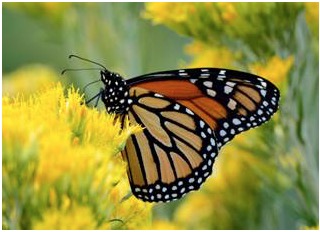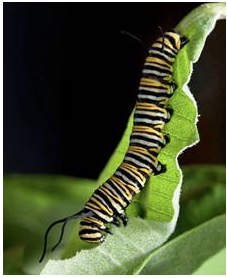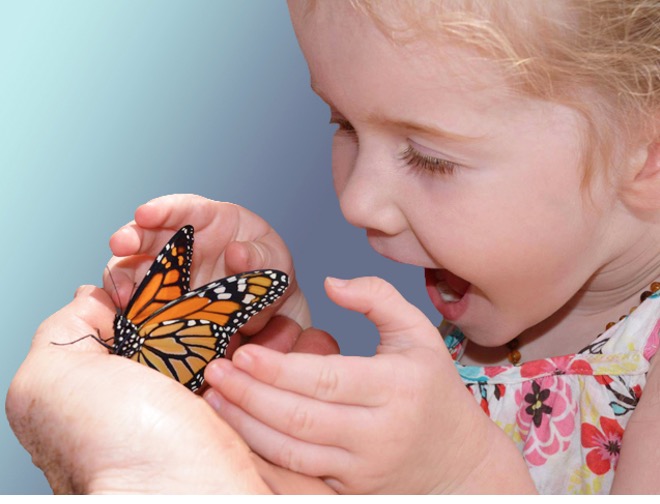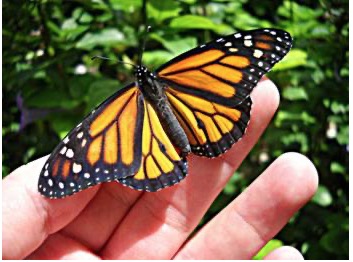Comments
ANIMAL WATCH - The portrait of pet ownership has changed dramatically in recent generations. For example, dogs and cats (the most common household pets) have been transformed dramatically, from providing protection and rodent control, to family companions which taught children responsibility for their care, and most recently have become “fur babies”—a substitute for human children.
With children now mesmerized by computers, phones or other electronic screens most waking hours, opportunities to interact with the non-verbal creatures outdoors that support the earth’s atmosphere are largely non-existent or ignored.
The magnificent Monarch Butterfly needs to be saved by caring humans and can be an exciting “pet” project to do with children. Following is some of the information which might help you decide if this low maintenance “pet” would be a suitable fit for your home (indoor “habitat”) and/or yard. In addition to being a low-maintenance and low-cost pet, children can learn environmental responsibility and have the satisfaction of playing a role in helping to save our planet.
Unlike dogs, cats, and rabbits, which are a daily commitment of well over a decade, and involve expensive veterinary bills, raising butterflies can be an affordable, relaxing, soothing connection with nature that can yield a rewarding contribution to the planet within a few weeks.
Monarch Butterfly Declared Endangered (IUCN)

In a July 21, 2022, media release the International Union for Conservation of Nature (IUCN) reported that, “(t)he migratory monarch butterfly known for its spectacular annual journey of up to 4,000 kilometers across the Americas, has entered the IUCN Red List of Threatened SpeciesTM as Endangered, threatened by habitat destruction and climate change.

A monarch caterpillar feeds on common milkweed, Asclepias Syriaca. Milkweed plants, primarily from the genus Asclepias, are the only food source of monarch caterpillars (USDA).
It is vitally important that only the proper milkweed is provided.
See: Which Milkweeds Do Monarch Butterflies Prefer? (USDA)
A World Without Butterflies?
With the advent of concrete jungles as living spaces, fewer children have areas where they can smell, feel and play on grass and under trees which connect them with nature and the insects and other creatures that contribute to and stabilize our environment.
There are very affordable ways to provide an environment that will attract and protect these butterflies, plant the milkweed that nourishes them, and children can participate in each step.
Raising Monarch butterflies does not require a great deal of time—although the care must be regular and precise, and the butterflies must be released on a strict schedule.
Fascinating Facts About Butterflies

- Butterfly wings are transparent.
- There are almost 20,000 butterfly species
- Butterflies use their feet to taste.
- Butterflies only live for a few weeks.
- The most common butterfly in the US is the Cabbage White.
- Butterflies have a liquid diet.
- Butterflies actually have four wings, not two.
(See more here.)
Raising Butterflies with Children

The following is extracted from a very informative and important site, called (Raising Monarch Butterflies with Children). There is much more helpful information provided by this mother who is an expert:
The Importance of The Monarch Butterfly
Monarch butterflies are pollinators…and play a vital role in the natural ecosystem and our food system. As pollinators, the monarch butterfly migration across the continent provides an invaluable service, essential for many ecosystems to thrive.
But monarch butterflies and their migration are now threatened by temperature changes, drought, deforestation, development, and other impacts.
The loss of milkweed plants (due to eradication, urbanization and increased use of herbicides), loss of winter habitat, and climate change are all pushing monarchs to the brink.
The Need to Raise Monarch Butterflies in Captivity
In nature, monarchs are prey to various predators, and only ten percent of monarch eggs in the wild make it to the butterfly stage.
Even without the threat of predators, bacterial and viral diseases are also ever-present and cause widespread damage….
Raising monarch butterflies with your children in captivity can help protect these eggs and ensure they are safely brought into adulthood and help the recovery of the monarch butterfly population. It’s one little thing we can do with our children to help make a difference.
Video Resources on Raising Butterflies (For Kids)
Parents should view in advance, in order to be prepared to answer questions:
Life Cycle of a butterfly | Butterflies for Kids | Learn the 4 stages of the butterfly life cycle
My Animal Friends - a Butterfly (Monarch Butterfly) | Wizz | TV Shows for Kids
A quick Google or Amazon search will reveal a variety of available information and kits for as low as about $10.
If you have expertise in protecting or raising Monarch butterflies, please share your comments and suggestions on this topic.
(Phyllis M. Daugherty is a former Los Angeles City employee, an animal activist and a contributor to CityWatch.)






